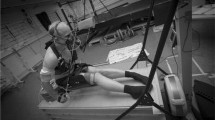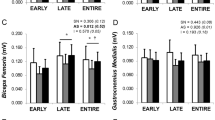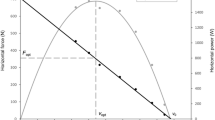Abstract
A group of 15 untrained male subjects pedalled on a friction-loaded cycle ergometer as fast as possible for 5–7 s to reach the maximal velocity (V{immax}) against different braking forces (F B). Power was averaged during a complete crank rotation by adding the power dissipated againstF B to the power necessary to accelerate the flywheel. For each sprint, determinations were made of peak power output (\(\dot W_{peak}\)) power output attained atV max (\(\dot W_{vmax}\)) calculated as the product ofV max andF B and the work performed to reachV max expressed in mean power output (\(\bar \dot W_{vmax}\)). The relationships between these parameters andF B were examined. A biopsy taken from the vastus lateralis muscle and tomodensitometric radiographs of both thighs were taken at rest to identify muscle metabolic and morphometric properties. The\(\dot W_{peak}\) value was similar for allF B. Therefore, the average of values was defined as corrected maximal power (\(\dot W_{max}\)). This value was 11 higher than the maximal power output uncorrected for the acceleration. Whereas the\(\dot W_{max}\) determination did not require high loads, the highest\(\bar \dot W_{vmax}\) value (\(\bar \dot W_{max}\)) was produced when loading was heavy, as evidenced by the\(\bar \dot W_{vmax}\)-F B parabolic relationship. For each subject, the braking force (\(F_{B,\bar \dot W_{max} }\)) giving\(\bar \dot W_{max}\) was defined as optimal. The\(F_{B,\bar \dot W_{max} }\), equal to 0.844 (SD 0.108) N · kg−1 bodymass, was related to thigh muscle area (r = 0.78,P < 0.05). The maximal velocity (\(\upsilon _{m,\bar \dot W_{\max } }\)) reached against this force seemed to be related more to intrinsic fibre properties (% fast twitch b fibre area and adenylate kinase activity). Thus, from the\(\dot W_{max}\) determination, it is suggested that it should be possible to predict the conditions for optimal exercise on a cycle ergometer.
Similar content being viewed by others
References
Andersen P (1975) Capillary density in skeletal muscle of man. Acta Physiol Scand 95:203–205
Bottinelli R, Schiaffino S, Reggiani C (1991) Force-velocity relations and myosin heavy chain isoform compositions of skinned fibres from rat skeletal muscle. J Physiol (Lond) 437:655–672
Brooke MH, Kaiser KK (1970) Three “myosin ATPase” systems: the nature of their pH ]ability and sulfhydryl dependence. J Histochem Cytochem 18:670–672
Denis C, Linossier MT, Dormois D, Padilla S, Geyssant A, Lacour JR, Inbar O (1992) Power and metabolic responses during supramaximal exercise in 100-m and 800-m runners. Scand J Med Sci Sports 2:62–69
Dotan R, Bar-Or O (1983) Load optimization for the Wingate anaerobic test. Eur J Appl Physiol 51:409–417
Evans JA, Quinney HA (1981) Determination of resistance settings for anaerobic power testing. Can J Appl Sport Sci 6:53–56
Fouquet R, Belli A, Jay J, Dumas JC, Denis C, Louis P, Bonnefoy R, Rougny R (1993) Système de mesure et d'exploitation de la puissance développée sur cycloergomètre. Innovat Technol Biol Méd 14:709–717
Gaitanos GC, Williams C, Boobis LH, Brooks S (1993) Human muscle metabolism during intermittent maximal exercise. J Appl Physiol 75:712–719
Häkkinen K, Komi PV, Alén M (1985) Effect of explosive type strength training on isometric force- and relaxation-time, electromyographic and muscle fibre characteristics of leg extensor muscles. Acta Physiol Scand 125:587–600
Hirvonen J, Rehunen S, Rusko H, Härkönen M (1987) Breakdown of high-energy phosphate compounds and lactate accumulation during short supramaximal exercise. Eur J Appl Physiol 56:253–259
Inbar O, Kaiser P, Tesch P (1981) Relationships between leg muscle fiber type distribution and leg exercise performance. Int J Sports Medicine 2:154–159
Jacobs I, Tesch PA, Bar-Or O, Karlsson J, Dotan R (1983) Lactate in human skeletal muscle after 10 and 30 s of supramaximal exercise. J Appl Physiol 55:365–367
Lakomy HKA (1986) Measurement of work and power output using friction-loaded cycle ergometers. Ergonomics 29:509–517
Lakomy HKA (1988) Measurement of external power output during high intensity exercise. Thesis, University of Technology, Loughborough
Larsson L, Moss RL (1993) Maximum velocity of shortening in relation to myosin isoform composition in single fibres from human skeletal muscles. J Physiol (Lond) 472:595–614
Linossier MT, Denis C, Dormois D, Geyssant A, Lacour JR (1993) Ergometric and metabolic adaptation to a 5-s sprint training programme. Eur J Appl Physiol 67:408–414
McCartney N, Heigenhauser GJF, Jones NL (1983) Power output and fatigue of human muscle in maximal cycling exercise. J Appl Physiol 55:218–224
Mercier J, Mercier B, Préfaut C (1991) Blood lactate increase during the force-velocity exercise test. Int J Sports Med 12:17–20
Mero A, Luhtanen P, Viitasalo JT, Komi PV (1981) Relationships between the maximal running velocity, muscle fiber characteristics, force production and force relaxation of sprinters. Scand J Sports Sci 3:16–22
Oliver IT (1955) A spectrophotometric method for the determination of creatine phosphokinase and myokinase. Biochem J 61:116–122
Patton JF, Murphy MM, Frederick FA (1985) Maximal power outputs during the Wingate anaerobic test. Int J Sports Med 6:82–85
Sargeant AJ (1994) Human power output and muscle fatigue. Int J Sports Med 15:116–121
Sargeant AJ, Hoinville E, Young A (1981) Maximum leg force and power output during short-term dynamic exercise. J Appl Physiol 51:1175–1182
Sargeant AJ, Dolan P, Young A (1984) Optimal velocity for maximal short-term (anaerobic) power output in cycling. Int J Sports Med 5:124–125
Schantz P, Randall-Fox E, Hutchison W, Tyden A, Astrand PO (1983) Muscle fibre type distribution, muscle cross-sectional area and maximal voluntary strength in humans. Acta Physiol Scand 117:219–226
Seek D, Vandewalle H, Decrops N, Monod H (1995) Maximal power and torque-velocity relationship on a cycle ergometer during the acceleration phase of a single all-out exercise. Eur J Appl Physiol 70:161–168
Simoneau JA, Lortie G, Boulay MR, Marcotte M, Thibault MC, Bouchard C (1987) Effects of two high-intensity intermittent training programs interspaced by detraining on human skeletal muscle and performance. Eur J Appl Physiol 56:516–521
Vandewalle H, Pérès G, Heller J, Monod H (1985) All out anaerobic capacity tests on cycle ergometers. Eur J Appl Physiol 54:222–229
Vandewalle H, Pérès G, Heller J, Panel J, Monod H (1987) Forcevelocity relationship and maximal power on a cycle ergometer. Eur J Appl Physiol 56:650–656
Wilson GJ, Newton RU, Murphy AJ, Humphries BJ (1993) The optimal training load for the development of dynamic athletic performance. Med Sci Sports Exerc 25:1279–1286
Author information
Authors and Affiliations
Rights and permissions
About this article
Cite this article
Linossier, M.T., Dormois, D., Fouquet, R. et al. Use of the force-velocity test to determine the optimal braking force for a sprint exercise on a friction-loaded cycle ergometer. Europ. J. Appl. Physiol. 74, 420–427 (1996). https://doi.org/10.1007/BF02337722
Accepted:
Issue Date:
DOI: https://doi.org/10.1007/BF02337722




